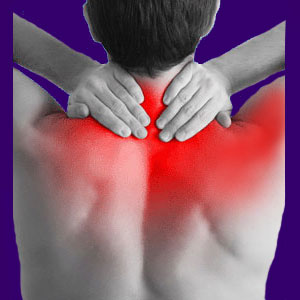
Neck and shoulder pain is a common combination of symptoms that affects many patients, reducing functionality and creating incredibly uncomfortable movement of the head and arms. The muscles of the neck and upper back are inherently interrelated and are often affected regionally when pain strikes.
When we discuss the shoulder in this article, we are not specifically discussing the shoulder capsule or the side of the shoulder at the top of the arm. Instead, we are discussing the shoulder scapula area and the space in between the shoulders on the dorsal anatomy. This basically covers the region starting in the neck and working downwards into the top two thirds of the thoracic spine.
This dialog focuses on combination symptoms expressed in the neck and shoulder areas of the body. We will detail why these pain syndromes occur, why they affect such a large region and what can be done to relieve the discomfort.
Shoulder and Neck Pain Locations
When discussing neck and shoulder pain, the symptoms might exist in large or small regions. Localized pain might occur mostly in the neck, unilaterally or bilaterally, and will likely radiate downwards into the region alongside the spine into the upper thoracic area. More diffuse pain might generally affect the neck, upper back and area in between the shoulder blades. Finally, large zones of pain might exist throughout the entire neck, upper back and shoulder, often encompassing the entire trapezius muscle, which attaches at the base of the skull and travels all the way down to T12, with the majority of muscle mass being centered in the upper thoracic spine.
Often, pain will exist on opposite sides of the spine at 2 different heights. For example, the neck might hurt at the base on the right side, while the upper middle back might hurt on the left. Other patients might have linear pain that travels down the same side of the spine from its starting point in the neck until its culmination in the upper or middle back.
Patients will often have difficulty turning their head or moving their arms. Once again, these symptoms might be expressed generally or through specific ranges of motion. Patients typically complain of extreme tightness and pain when moving in certain ways. Additionally, many patients find that moving the head will cause a pulling sensation lower in the thoracic spine, under the shoulder scapular region.
Neck and Shoulder Pain Causes
We always remind patients that the musculature of the dorsal anatomy is multilayered and mutually interrelated with the other soft tissues of the back. When pain occurs in one area, it is common for that discomfort to cause stress for related muscle groups nearby.
We also remind patients that muscles can become injured at areas where they interact or attach. This easily explains why so many patients experience pain in more than one area of the neck or shoulder anatomy, since the affected muscles work as a team to perform many of our physical functions.
Additionally, some muscular spasms can compress nerves and therefore might affect tissues along the neurological pathway. If a nerve is compressed in the neck, but serves tissues lower in the anatomy, those lower regions might also suffer pain and limited functionality. Likewise, if a spinal nerve root is compressed within the central canal, lateral recess or foraminal opening, symptoms may affect a linear path or regional area due to innervation patterns of muscular groups.
Injuries can affect several areas of the spine, with whiplash being a perfect example. In this case, acute hyperflexion and hyperextension of the neck and upper back can cause pain in several areas and might affect the spine itself or any of the surrounding soft tissues, such as muscles, ligaments and tendons.
Spinal abnormalities might create pain in the neck and shoulder. Scoliosis and various forms of lordotic and kyphotic irregularities, are all perfect examples of regionally painful processes in some patients, particularly when they occur at frontier regions, such as at the cervicothoracic juncture.
Neck and Shoulder Pain Treatment
Most dual zone pain syndromes will resolve organically without any special care required. All it takes is time and some rest for the body to heal itself, as designed. In most cases, the secondary region of pain will slowly shrink and the severity of secondary pain will diminish first. The primary pain zone will likely take slightly longer to completely resolve.
Some painful conditions will benefit from mild symptomatic care modalities, such as massage, heat or ice, chiropractic or acupuncture. The use of OTC drugs is acceptable, as long as the patient is careful about ingesting these generally hazardous substances. Prescription pain medications should only be taken if the symptoms are extreme, since these drugs demonstrate very significant risks to general health.
Some conditions might require professional healthcare intervention, such as spinal pinched nerves, some forms of spinal curvature and detached muscular, tendon or ligamentous injuries. Some patients might require conservative care, such as physical therapy, while others may require injection or surgical-based practices to resolve their pain.
Your physical therapist is an excellent resource when it comes to diagnosing multi-location symptom syndromes, like neck and shoulder pain, and will likely recommend conservative care. It is for this reason that we generally suggest seeking their advice when it comes to severe and unresponsive dual zone pain problems in the neck and shoulder.





